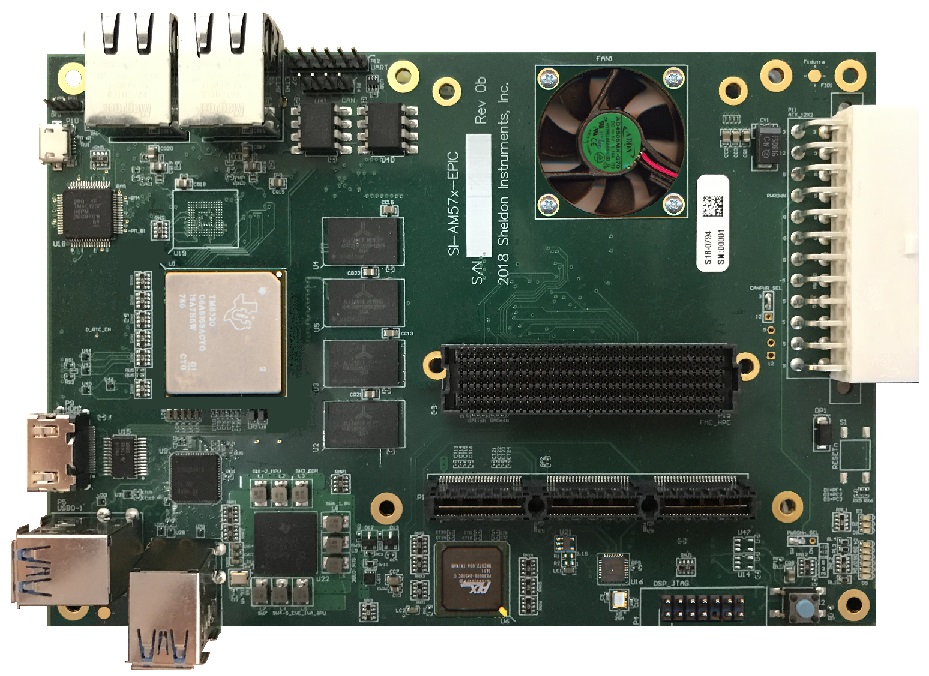

The SI-AM572xDSP from Sheldon Instruments is an ARM plus Digital Signal Processor (DSP) carrier card with PCIe-104 and optional FMC expansion ports that may run Linux and be a C programmable platform intended for low power environments that require intensive computing in a cost sensitive solution.
Sitara devices supported on the SI-AM572xDSP card:
AM5728DSP
AM5726DSP
The SI-AM572xDSP is a Small Form Factor (SFF) family of Commercial Off the Shelf (COTS) carrier cards featuring the powerful Sitara AM572x ARM plus DSP video processor from Texas Instruments. The TI AM572x devices are multicore ARM + DSP System on Chip (SoC) able to run Linux or Android OSes, equipped with multiple I/O ports, making for an ideal host carrier platform with PCIe-104 expansion.
There are separate ARM, GPU, and DSP subsections, with the ARM consisting of a pair of Cortex A15 clocked at 1.5GHz, the GPU featuring a pair of SGX544 3D cores, and with the DSP consisting of a pair of C66x VLIW cores clocked at 750MHz.
As an industry first, a novel Programmable Real-Time Unit (PRU) consisting of a pair of Dual Cortex-M4 controllers are available as a powerful C programmable logic engine, similar to an FPGA. The great advantage of the ubiquitous C language significantly reduces the complexities of VHDL or Verilog languages required for programming FPGAs.
All of this is attained at less than 8 watts of power consumption while most processors of this caliber are in the 60W range.
High Speed Serial Interfaces: PCIe, GbE, & SATA
There are multiple standard high speed interfaces ranging from PCI Express Gen2, Gigabit Ethernet and SATA along with industrial interfaces such as UARTs and CANbus.
Hardware Expansion with PCIe-104 and PRU to FMC
There are two hardware expansion sites on the SI-AM572xDSP, with the first consisting of a PCIe-104 expansion site capable of stacking up to four (4) single lane PCIe-104 modules.
The second expansion site takes advantage of the Sitara’s novel Programmable Real-Time Unit that can be used as an FPGA substitute, complete with a myriad of multi-function customizable digital I/Os, with access to all internal device resources. The PRU lines are routed to an FPGA Mezzanine Card (FMC) expansion connector.
Flexible PCIe-104 and FMC expansion sites make it ideal for those who prefer to leverage a wide array of 3rd party industry standard modules, use their own custom hardware or simply update legacy designs with minimal effort.
Upgrades & Options
Upgrade options for the SI-AM572xDSP include various core and memory configurations, nonvolatile storage, and either commercial or expanded temperature ranges. A full line of software development tools are available from Sheldon Instruments and TI for Windows and Linux platforms.
The SI-AM572xDSP is available with extensive development tools from Sheldon Instruments and TI’s Code Composer Studio Integrated Development Environment (CCS) that include the Reference Design Kit (RDK) for both the ARM side as well as the DSP side.
Host and ARM Side Tools
For the ARM or host side, Sheldon Instruments provides:
DSP Side Tools
For the DSP side, Sheldon Instruments provides various TI CCS projects, both compiled versions for quick loading with the ARM side sample program, along with complete projects and related source code. These DSP projects include:
Processor for SI-AM572xDSP
[table class=”siTB”]
TI Sitara AM572x Family[attr colspan=”3″]
Number of Cores, AM572x, 2 ARM + 2 DSP
DSP Subsection (C66x VLIW)[attr rowspan=”3″], Clocking, 750MHz
MIPS/MFLOPS, -/-
L2 Cache/SRAM, 288KB
ARM Subsection (Cortex A15)[attr rowspan=”3″], Clocking, 1.5GHz
MIPS, –
L2 Cache, 2.5MB
[/table]
External Memory
[table class=”siTB”]
DDR3 Memory[attr colspan=”3″]
Port A[attr rowspan=”2″], Size, 2GB (512M x 32)
Speed, 1066Mhz
Port B[attr rowspan=”2″], Size, 2GB (512M x 32)
Speed, 1066Mhz
[/table]
[table class=”siTB”]
Storage / Nonvolatile Memory[attr colspan=”2″]
GPMC, up to 4GB eMMC NAND Flash
SPI, microSD flash card
I2C, up to 2KB EEPROM (inside Tiva uC)
[/table]
High Performance Serial Interfaces
[table class=”siTB”]
Interface, Lanes, Ports, Speed
PCI Express Gen2, 2, 1, 5 Gbps
Serial ATA, 1, 1, 3 Gbps
Gigabit Ethernet, 1, 2, 10/100/1000 Mbps
USB 3.0, 1, 4, 5 Gbps
Digital Video: HDMI 1.4a[attr rowspan=”2″], 1[attr rowspan=”2″], 1[attr rowspan=”2″], up to 148.5Mhz pixel clock with deep color mode
up to 186Mhz pixel clock with no color mode
CAN 2.0B, 1, 1, 1 Mbps
UART, 1, 1 stock; up to 4 more on PRUs, 3-12 Mbps
microSD, 4, 1, 24 Mbps
[/table]
Connectors for Ports and Peripheral Expansion
[table class=”siTB”]
Port Connectors[attr colspan=”3″]
DSP Ports (all form factors)[attr rowspan=”7″], PCIe Gen 2, 1 port: expansion over PCIe-104 stack for up to 4 cards; or Thunderbolt cable
Ethernet, 2 ports: RJ45 with integrated magnetics and LED indicators
USB 3.0, 4 ports: x2 dual standard Type A
HDMI 1.4a, 1 port: Type A
Serial ATA, 1 port: standard receptacle for DVD/CDROM/HDD
microSD, 1 port: standard socket for microSD/SPI flash
JTAG, 1 keyed 14 pin (2×7) header; compatible with all third party emulators and debuggers
Tiva uC, USB, microAB for card configuration
[/table]
[table class=”siTB”]
Optional Peripheral Expansion[attr colspan=”2″]
FMC/Parallel Expansion (attached to Programmable Real-Time Unit/PRU)[attr rowspan=”2″], Single Width FMC site (HPC 400 pin connector)
Mutli-function PRU User defined I/Os: complete LA bus (68 single ended I/Os); complete HA bus (48 single ended I/Os); partial HB bus (4 single ended I/Os). Note: Excludes all 10 multi-gigabit transceiver pairs on FMC.
[/table]
Mechanical Properties
[table class=”siTB”]
Physical Dimensions / Electrical Requirements / Temperature[attr colspan=”2″]
Form Factor Dimensions[attr rowspan=”2″], EPIC: 6.5″/16.5cm(L) x 4.53″/11.5cm(W)
PCIe-104: 4.55″/11.6cm(L) x 3.775″/9.59cm(W)
Weight, 0.31lbs/140 grams
Supply Voltages, 3.3V @ 0.75A and +12V @ 1A
Power, 12 Watts typical; up to 15W maximum
Temperature, Commercial grade 0-85C. Consult factory for availability of industrial and military temperature grades
[/table]
PCIe-104 Form Factor Cards
[table class=”siTB”]
Product, Description, Price (US dollars)
SI-AM5728-PCIe104, AM5728, Call
SI-AM5726-PCIe104, AM5726, Call
[/table]
EPIC Form Factor Carrier Cards
[table class=”siTB”]
Product, Description, Price (US dollars)
SI-AM5728-EPIC, AM5728, Call
SI-AM5726-EPIC, AM5726, Call
[/table]